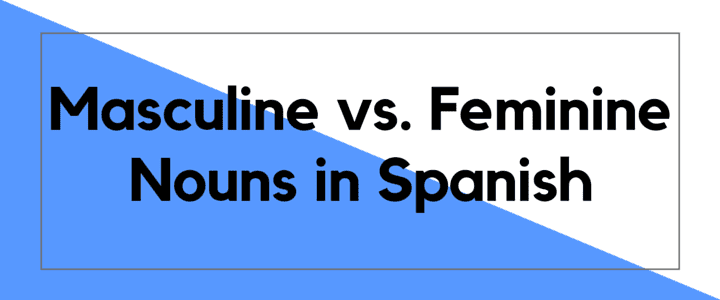In English, every noun has a neutral gender. This makes it easy to learn, so you really only need to learn the new word and the learning stops there.
In Spanish, on the other hand, every single noun is either masculine or feminine. This means that every time you learn a new Spanish vocabulary word, you need to learn its accompanying gender as well. This may appear confusing for beginners, but bear with me!
Here are the general rules for determining masculine and feminine Spanish nouns:

- Nouns that are feminine often (but by no means always) end in -a.
- By contrast, nouns that are masculine often (but by no means always) end in -o, or many other consonants.
- When a noun is masculine, we use the el definite article for a singular noun, and the los article for a plural noun, (both mean “the” in English) to represent the noun’s masculinity.
- When a noun is feminine, we use the la definite article for a singular nouns and the las article for a plural noun (both also mean “the” in English) to represent the noun’s femininity.
For example, el carro (the car) and la casa (the house).
Using a noun’s gender correctly also depends on differentiating plural nouns to singular nouns.
For example, los carros
By contrast, las casas
If you want to say “a,” the indefinite instead of the definite article “the,” you use un or unos, or una and unas respectively.
For example, un carro or unos carros
By contrast, una casa or unas casas
The noun’s gender follows it when it’s being described with adjectives. If the adjective is describing a masculine word, it most likely end in -o, whereas an adjective describing a feminine word most likely ends in -a. Its plurality or singularly continues into the noun’s corresponding description, unlike English!
For example, el/un carro bonito or los/unos carros bonitos
By contrast, la/una casa bonita or unas casas
Translations: the/a beautiful car, the/some beautiful cars
However, if only it were that simple…
Nouns that end in -a that have Greek origins go against the natural assumption and are actually masculine nouns.
Some examples of this are:
- El problema instead of la problema (problem)
- El tema instead of la tema (theme)
- El dilema instead of la dilema (dilemma)
There are also a few feminine nouns that end in -o, such as la mano (hand).
Test Yourself!
Think you’ve got it? Take this quiz to test your knowledge of masculine and feminine Spanish nouns!
[playbuzz-item url=”//www.playbuzz.com/takelessons12/how-well-do-you-know-masculine-and-feminine-nouns-in-spanish”]
The bottom line here is to start paying attention to a noun’s gender immediately when you learn the noun, so you can start identifying patterns. When I first began learning Spanish, I glossed over this crucial distinction which made it much more difficult for me later on.
So start early, and start learning with a private Spanish tutor! It’s not too difficult once you internalize that learning a noun’s gender is indispensable to learning Spanish vocabulary.
Let’s end by being grateful that Spanish only has two genders, whereas German, and many other languages also have neutral nouns, making three genders possible! Now that’s really confusing!
Editor’s Note: Want even more tips? We like this article about memorizing genders from the 5-Minute Language blog.
 Post Author: Jason N.
Post Author: Jason N.Jason N. tutors in English and Spanish in Athens, GA. He majored in Spanish at UC Davis, lived in Mexico for 3 years where he completed a Master’s degree in Counseling, and studied Spanish Literature and Psychology at the University of Costa Rica. He is currently attending the University of Georgia. Learn more about Jason here!
Suzy S.

